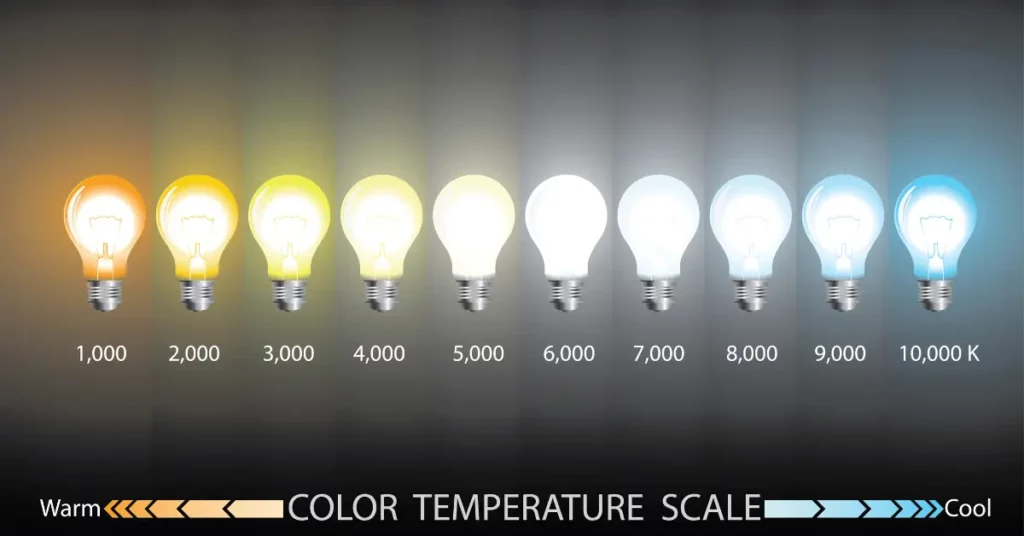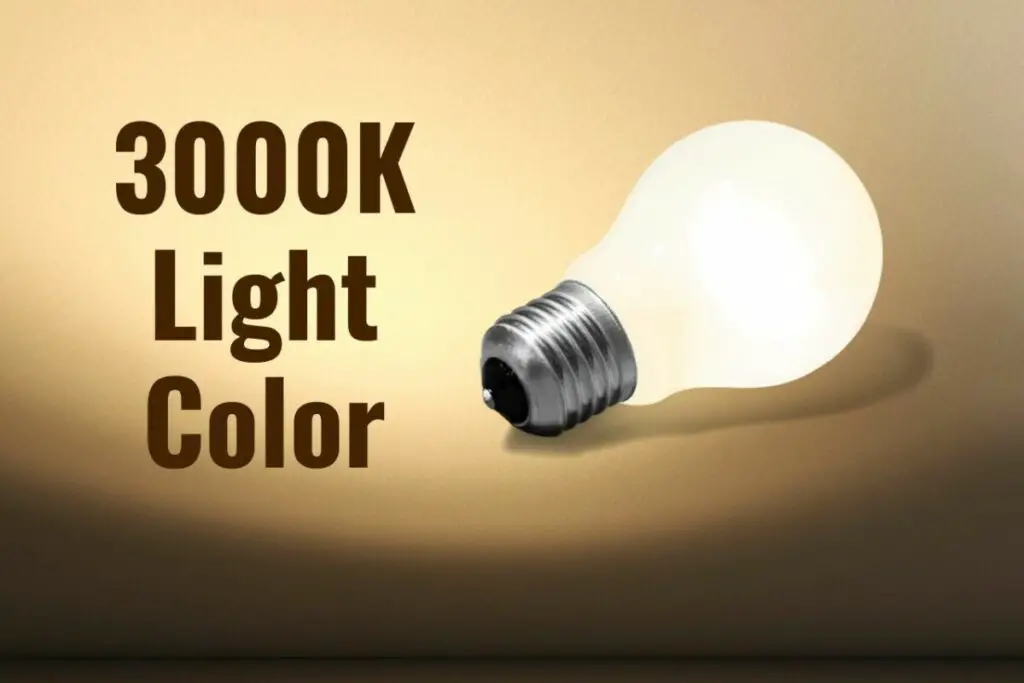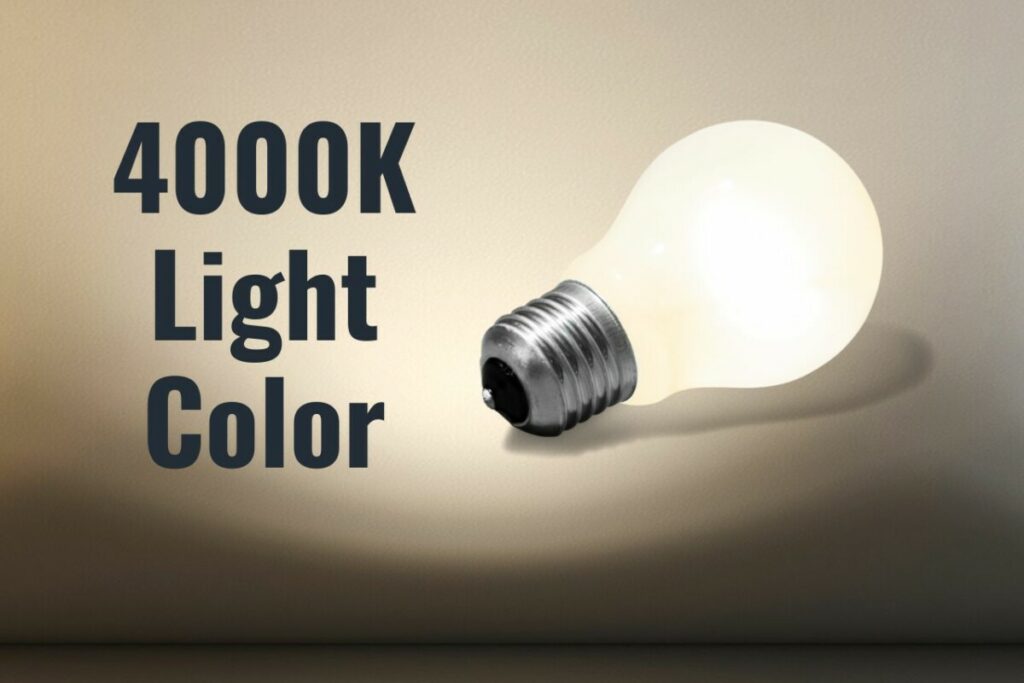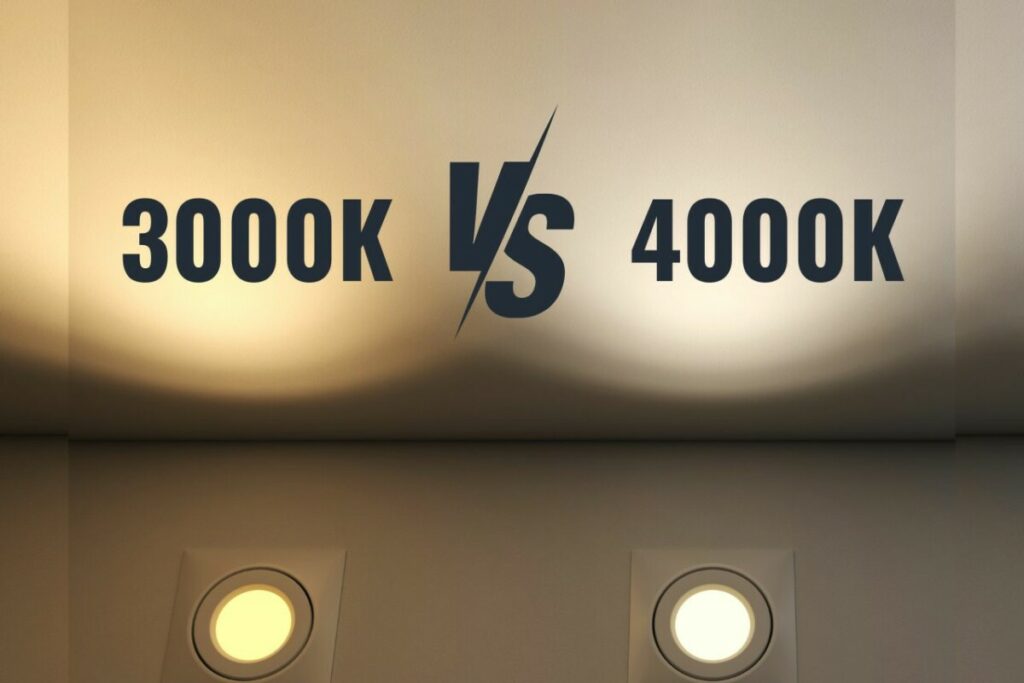When lighting up your space, choosing the right color temperature between 3000K vs 4000K can make a world of difference. Both of these light color temperatures impact your mood, ambiance, and even your productivity and well-being differently.
3000K vs 4000K LED light refers to different color temperatures. 3000K typically emits a warmer, yellowish light, which is used for cozy environments or residential settings. Conversely, 4000K emits a neutral, whiter light, mostly preferred for task-oriented spaces like offices or kitchens.
In this blog post, I’ll give the lowdown on whether to go with 3000K or 4000K lighting for different spots around your place.
Let’s light it right!
Understanding LED Color Temperature

Since you are here looking for guidance on the right color temperature, 3000K vs 4000K, I get that you actually care about the right light in your space.
The terms “3000K” and “4000K” refer to specific color temperatures commonly found in LED lighting. But before directly jumping to their differences, we need to understand the basics of LED color temperature. Thus, you can choose the right lighting for your space.
Defining Color Temperature
First things first, let’s talk about what color temperature even means.
Essentially, light color temperature describes the color appearance of the light emitted by a lightbulb or fixture. It is a measure of the warmth or coolness of the light. When you see a cozy, warm glow, that’s one end of the spectrum, and when you encounter a crisp, cool light, that’s the other end.
These color temperatures are measured on a color temperature chart known as Kelvin scale. The higher the LED light color temperature, the cooler or bluer the light appears. Similarly, lower color temperatures result in warmer or yellower light.
Demystifying Kelvin Scale
Now, let’s get into the nitty-gritty of the Kelvin scale. Don’t worry; I won’t throw too much jargon at you!
The Kelvin scale is a way to measure color temperature, and it’s based on the temperature at which a theoretical “black body” radiates light. Sounds fancy, right?
Basically, the Kelvin scale is used to measure color temperature, which helps us understand whether an LED light source will appear warm or cool. It starts from absolute zero (-273.15°C or -459.67°F), where molecular movement ceases and extends upward.
Unlike the Celsius or Fahrenheit scales, the Kelvin scale used for color temperature doesn’t have negative values. Instead, it starts at around 1000K for the warmest colors (like candlelight) and can go up to 10000K or higher for cooler colors (like blue sky on a sunny day).
So, when we talk about 3000K versus 4000K, we are referring to where they fall on this scale. 3000K light is on the warmer side, while 4000K leans towards the cooler end of the scale.
What is 3000K Color Temperature?

Do you know that vibe you get when you’re chilling by a cozy fireplace or enjoying a candlelit dinner? That warm and inviting feeling? Well, that’s what the 3000K color temperature feels like.
3000K light is this soft, amber, yellowish glow similar to traditional incandescent bulbs. This warm light color is perfect for spaces where you want to feel comfy and cozy, like your living room, bedroom, or an earthy restaurant or café.
Warm and Inviting Glow
In terms of color temperature, 3000K is a warm color light. A 3000K light source appears visually warm, creating a cozy ambiance. But fortunately enough, this LED light color does not emit heat in the same way as a radiator or a fireplace.
And get this – the 3000K light isn’t just about the ambiance. The warmth of 3000K light can have a psychological impact, evoking feelings of comfort, intimacy, and relaxation. Plus, it makes your space look even better, giving off those welcoming vibes. In residential settings, it’s a top pick for setting the mood and making it feel homey and inviting.
Is 3000K hot or cold?
Now, let’s clear up this confusion!
Is 3000K hot or cold? 3000K light color is on the warmer side of the spectrum. It’s not scorching hot, mind you – we’re not roasting marshmallows here – but it’s definitely leaning towards the toasty, comforting end.
So, 3000K is not too hot nor too cold – just right for creating that perfect ambiance for a cozy night in. To put it in simple terms, 3000K light is the kind of warmth that makes you feel all snug and content, like a hug from your favorite blanket.
What is 4000K Color Temperature?

4000K color temperature is a balance between warm and cool tones. It provides a crisp and clean glow that is ideal for settings like offices, retail spaces, and even your home.
To put it simply, 4000K light mimics natural daylight to some extent, reducing eye strain and creating a more comfortable working environment.
Cool and Crisp Glow
At 4000K, the light emitted tends to have a balanced glow. This temperature is mainly associated with environments where clarity and visibility are essential.
4000K is neither too hot nor too cold. Instead, it balances warm and cool tones, making it a popular choice for neutral lighting.
Is 4000K Hot or Cold?
Describing 4000K light color temperature as “hot” or “cold” can be a bit misleading. 4000K light color, being closer to the middle of this spectrum, is generally perceived as neutral.
You won’t find it leaning too heavily towards warm or cool tones. Hence, it’s often described as neutral white. However, some people still perceive it as slightly cool due to its proximity to higher color temperatures.
3000K vs. 4000K: What are The Differences?
On the Kelvin color temperature scale, 3000K is on the warmer side, emitting a yellowish hue that gives off a cozy, inviting glow. In contrast, 4000K leans towards the cooler end of the Kelvin scale, which offers a bright, energizing light.
Here is a detailed table comparing 3000K and 4000K so you can make the right decision for your space when choosing between these two color temperatures:
| Difference Between 3000K vs 4000K Color Light Temperature | ||
| Point of Difference | 3000K Light | 4000K Light |
| Color | Warm white (3000 Kelvin) | Neutral to cool white (4000 Kelvin) |
| Appearance | Yellowish-white | Neutral white |
| Application | Residential, hospitality, and ambient lighting | Commercial, retail, offices, task lighting |
| Mood | Creates a cozy, intimate atmosphere | Creates a bright, energetic atmosphere |
| Ideal Use Cases | Living rooms, bedrooms, restaurants, lounges | Offices, kitchens, bathrooms, retail spaces |
| Lighting Effect | Soft and relaxing | Crisp and vibrant |
| Recommended for | Areas where comfort and relaxation are desired | Areas where focus and productivity are important |
| Common Fixtures | Table lamps, wall sconces, pendant lights | Ceiling lights, under-cabinet lights, track lighting |
| 💡 PRO TIP 💡 Try out Dimming Options! Invest in dimmable lighting fixtures to have greater control over the intensity and ambiance of your space. The dimmer switch allows you to dim the brightness of both 3000K and 4000K lights according to your preferences and needs. |
What is better, 3000K or 4000K?
Here’s the deal: there’s no right or wrong answer when choosing between 3000K vs 4000K. It all boils down to the vibe you want to create in your space and what activities you’ll be doing there.
Want to evoke a sense of warmth and intimacy? Go for 3000K light color.
Need to stay focused and alert? Opt for 4000K color temperature.
But that’s not all! You are, by no means, restricted to making either of these two choices. If you’re feeling creative and want to delve into some experiment, why not mix and match?
Layering different color temperatures can add depth and dimension to your lighting design. It will create a dynamic atmosphere that evolves throughout the day.
The takeaway is that the ultimate choice comes down to your preferences: the intended use of the space, personal liking, and the desired ambiance. You should also consider the specific requirements of the area where the lighting will be used before making a decision.
3000K vs. 4000K: How To Choose Between These Light Colors?
When choosing between 3000K and 4000K, you need to consider their impact and how they complement your home interior, art, and decor.
Let’s break it down in an easy way:
Impact on Mood
Light color temperature can significantly affect mood. Generally, warmer colors like 3000K (which emits a soft white or warm white light) create a cozy and inviting atmosphere. 3000K is associated with relaxation and comfort. This psychological impact makes it ideal for spaces you want to unwind, such as bedrooms, living rooms, or dining areas.
On the other hand, cooler colors like 4000K (which emits a neutral or cool white light) can ignite a sense of alertness and focus. 4000K light color is preferred in workspaces or areas where concentration is critical, such as offices or study rooms.
Impact on Eye Health
The impact of LED light colors on eye health is significant, especially considering how much time we spend indoors under artificial lighting. Hence, you need to find the best color light for your eyes to prevent eye strain and discomfort.
Warm white lights, like 2700K or 3000K, tends to be easier on the eyes, causing less strain and fatigue, particularly during nighttime or low-light conditions. Cooler white light, such as 4000K, provides better visibility and clarity. According to a study by the Lighting Research Center, 4000K lights do not cause more eye strain than 3000K lights. All you need to do is make sure they are dimmed to the correct brightness level before you start winding down.
However, prolonged exposure to 4000K lights can result in eye strain, and headache. This effect can be noticeable if the lighting is too harsh or glaring.
So, it doesn’t matter if you’re team 3000K or 4000K. As long as you’re feeling good and your eyes aren’t protesting, you’re golden!
Impact on Productivity and Focus (Analyzing Glare and Eye Strain)
Every lighting enthusiast like me will agree that lighting plays a chief role in productivity and focus.
Need to get in the zone? 4000K light is like a shot of espresso for your brain — keeping you alert and on point. Being closer to natural daylight, 4000K can help boost alertness and concentration levels. This quality makes it suitable for work environments where high productivity is essential.
On the flip side, 3000K light is more laid-back. This light color temperature creates a more relaxed ambiance. While it may not be as conducive to intense concentration, it can still promote a comfortable and pleasant environment for tasks that require less cognitive demand. Simply put, 3000K light is perfect for unwinding.
Impact on Spatial Perception
Light color temperature can influence how we perceive space. It can totally change how big a space feels. Cooler white light, like 4000K, tends to make spaces appear brighter and bigger. This quality can benefit cramped spots or places with limited natural light.
But if you’re all about that cozy, vintage ambiance, 3000K light is the color temperature to go for. Warm white light, such as 3000K, can create a more intimate and cozy atmosphere. This hue might be preferable in larger spaces or rooms where a sense of warmth and intimacy is desired. Mind you, 4000K is better than 3000K light color when it comes to making your room look bigger.
Impact on Your Home Interior, Art, and Decor
Thinking of choosing 3000K or 4000K light colors to make your home interior pop? It’s imperative to consider how they will complement your decor and accentuate artwork or architectural features.
Warm white light (3000K) enhances warmer tones in your furniture and art, giving your space major cozy vibes. This light color can also add depth and richness to artwork, which makes colors appear more vibrant and saturated.
On the other hand, cool white light (4000K) can provide better color accuracy, crisp details, and clarity. For spaces where visual acuity is essential, 4000K light is like Instagram filters in real life, making everything look sharp and on point.
| 💡 PRO TIP 💡 Factor in Decor and Color Scheme! Consider how each color temperature complements your existing decor and color scheme. Warm white lighting (3000K) may enhance warmer tones, while neutral white lighting (4000K) can provide better color accuracy and clarity for contemporary spaces. |
3000K vs. 4000K: Which Color Temperature to Use in Different Settings?
While both 3000K and 4000K fall within the warm white spectrum, they offer distinct characteristics suitable for various environments.
Let’s delve into each setting to determine which color temperature – 3000K or 4000K – is more appropriate:
3000K vs. 4000K for the Living Room
The living room serves multiple purposes, from relaxation to entertaining guests.
That’s where 3000K comes in handy. A warmer and softer ambiance is mainly preferred to create a cozy atmosphere conducive to socializing and unwinding.
The 3000K light emits a gentle, inviting glow that enhances the room’s comfort and promotes relaxation. Plus, it meshes well with warmer colors like wood or earth tones, making the whole space feel super comfy.
3000K vs. 4000K for Bathroom
Now, the bathroom’s a bit of a balancing act between functionality and aesthetics.
You need enough light to see what you’re doing – like when you’re getting ready in the morning – but you also want it to feel fresh and welcoming.
That’s why 4000K is a good call here to strike a balance! It’s bright enough for tasks like doing your makeup, giving the room this clean, refreshing natural daylight vibe.
This cooler temperature can also help accurately render colors, making it easier to assess skin tones and clothing colors.
3000K vs. 4000K for Bedroom
When it’s time to hit the hay, you want your bedroom to feel like a cozy sanctuary. Soft, warm lighting helps create a calming environment conducive to winding down and promoting sleep.
According to research, exposure to blue light, which is prevalent in cooler lights like 4000K, can disrupt our sleep patterns.
That’s why 3000K lighting is a relatively better color light for sleeping. This color casts a gentle glow perfect for winding down and aiding the body’s natural circadian rhythm. Thus, you can quickly get ready to catch some Z’s.
Learn how to put LED lights under bed for a comfortable and cozy ambiance.
| 💡 PRO TIP 💡 Take Ambiance Control in Your Hands! Transform your lighting experience by teaming up your 3000K lightbulb with a dimmer switch. With this dynamic duo, you can effortlessly adjust the brightness to match your activities. Whether delving into a good book or winding down before bedtime, you will have versatility and ambiance control at your fingertips! |
3000k or 4000k for Kitchen
The kitchen is a multifunctional space where we need both task-oriented and ambient lighting. That’s where 4000K color temperature lighting comes into play. It’s bright enough to help you see what you’re chopping and cooking.
In fact, the cooler hue also aids in distinguishing between food colors and assessing freshness. Plus, 4000K lighting can create a clean, modern aesthetic, complementing stainless steel appliances and contemporary kitchen designs.
3000k vs. 4000k for Office
According to studies, lighting in the workplace can significantly impact your productivity, efficiency, focus, and overall well-being on the job. For this particular use, natural lighting is deemed one of the best types of lighting.
However, if your home office lacks natural lighting, you can use artificial lighting to make up for it. The only important thing is to find a healthy balance between dim and bright lighting in a workspace.
Here, 4000K lighting lighting comes in clutch. It’s bright enough to keep you alert and focused throughout the day. Hence, you can power through those work tasks. The cooler temperature also mimics natural daylight, which keeps you awake and productive and boosts cognitive performance.
But don’t just take my word for it. Research shows that people who read under warm white LEDs are 5% better on reading comprehension tests as compared to those who read under cool white LEDs. This could make a big difference in exam results, potentially turning your passing grade into a top score.
| 💡 PRO TIP 💡 Experiment with Samples! If you’re unsure which color temperature to choose, experiment with samples of 3000K and 4000K lighting in different areas of your home. This hands-on approach allows you to see how each temperature affects the ambiance before making a decision. |
FAQs: 3000K vs. 4000K Light Bulb
What is the difference between 2700K vs 3000K?
Both 2700K and 3000K fall within the warm spectrum of light temperatures. The key difference between 2700K vs 3000K lies in the tone of these light colors. 2700K tends to have a slightly warmer, yellowish hue than 3000K, which is somewhat cooler and more neutral.
What is the difference between 4000K vs 5000K?
The difference between 4000K and 5000K is in their color temperature. 4000K produces a neutral white light, whereas 5000K emits a cooler, more daylight-like light.
What is the difference between soft white and daylight?
The difference between soft white vs daylight is that soft white light typically refers to warmer color temperatures (around 2700K to 3000K) resembling the warm glow of incandescent bulbs. In contrast, daylight refers to cooler color temperatures (around 5000K) resembling natural daylight.
What is the difference between bright white and daylight?
Bright white and daylight both refer to cooler color temperatures, but bright white typically falls around 4000K, while daylight is usually closer to 5000K.
Can you mix 3000K and 4000K lights?
Yes, you can mix 3000K and 4000K lights, although it may create a slightly inconsistent ambiance as they emit different color temperatures.
Which is warmer 3000K or 4000K?
A 3000K light is warmer than a 4000K light. The lower the Kelvin temperature, the warmer the light appears.
Is 4000K good for eyes?
Generally, 4000K light is comfortable for most people’s eyes, balancing warm and cool light. However, individual preferences may vary.
What is better, 3000K or 5000K?
The choice between 3000K and 5000K is all about personal preference and the intended use. 3000K offers a warmer, more relaxing ambiance, while 5000K provides a brighter, more energetic feel similar to daylight.
Is 3000K LED Lights Cool or Warm?
3000K LED lights emit a warm, cozy glow, perfect for a comfortable and inviting atmosphere. This light color is on the warmer end of the Kelvin color temperature scale.
Is The Light from 4000K LEDs Too Bright?
The brightness of 4000K LEDs can vary based on factors like lumens and fixture design, but generally, they provide a bright and well-lit environment without being excessively bright for most applications.
What is the difference between 3000k vs 4000k vs 5000k vs 6500k?
3000K emits a warm, yellowish light suitable for creating a cozy atmosphere. 4000K provides a neutral, slightly cooler light ideal for general indoor use. 5000K offers a bright, neutral light often used for task lighting. 6500K replicates daylight, appearing very bright and cool, suitable for areas requiring maximum visibility or simulating natural outdoor lighting.
Is 4000K light good for home?
Yes, 4000K light can be good for the home, especially in areas with a desired balance between warm and cool lighting. It provides a neutral white light that enhances visibility and creates a modern, inviting atmosphere.
Is 4000K brighter than 6000K?
Generally, yes, 6000K light is brighter than 4000K light. The higher the Kelvin temperature, the cooler and brighter the light appears. However, the perceived brightness also depends on factors like lumens output and fixture design.
Is 3000K light good for the bedroom?
Yes, 3000K light can be good for the bedroom. Its warm, cozy glow creates a relaxing ambiance that is conducive to winding down and promoting restful sleep. It’s often preferred for bedrooms and other spaces where comfort and relaxation are priorities.
Conclusion: 3000K vs. 4000K Lighting Color Temperature
3000K vs 4000K — these shades of white light aren’t just about brightness. They’re about crafting atmospheres and evoking emotions.
If you love basking in the gentle, golden glow, 3000K is the right light color temperature. If you are in a bright, sunlit room ready to tackle the day ahead, shift gears to the crisp, clear aura of 4000K light.
But beyond the practicalities, the choice between warm and cool light reflects your personality and the ambiance you crave. It’s about curating spaces that serve their function and stir your soul.
Whether you are drawn to the comforting embrace of 3000K or the refreshing clarity of 4000K, remember that lighting is your choice. Let your light choices illuminate your surroundings in the perfect glow.
